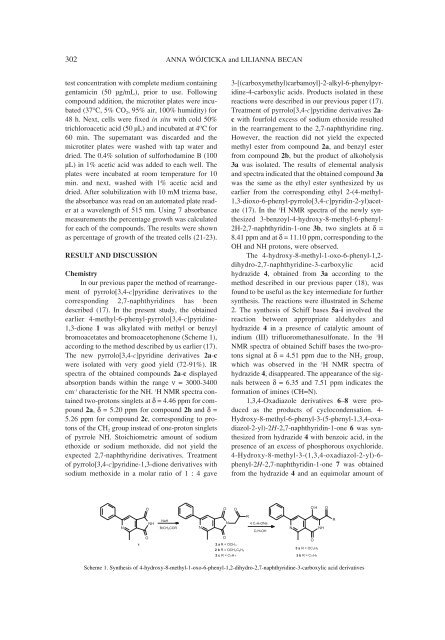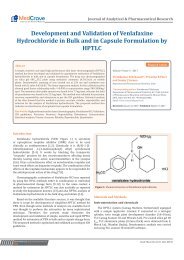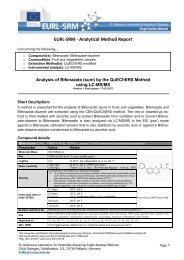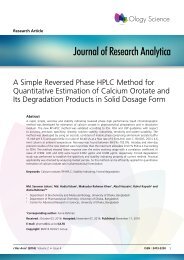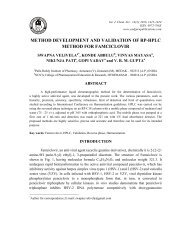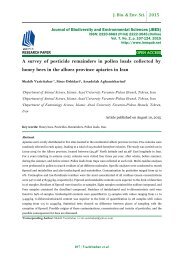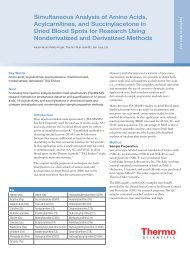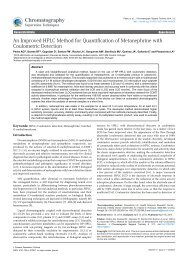acta 2_2015
acta 2_2015
acta 2_2015
- No tags were found...
You also want an ePaper? Increase the reach of your titles
YUMPU automatically turns print PDFs into web optimized ePapers that Google loves.
302 ANNA W”JCICKA and LILIANNA BECANtest concentration with complete medium containinggentamicin (50 µg/mL), prior to use. Followingcompound addition, the microtiter plates were incubated(37 O C, 5% CO 2 , 95% air, 100% humidity) for48 h. Next, cells were fixed in situ with cold 50%trichloroacetic acid (50 µL) and incubated at 4 O C for60 min. The supernatant was discarded and themicrotiter plates were washed with tap water anddried. The 0.4% solution of sulforhodamine B (100µL) in 1% acetic acid was added to each well. Theplates were incubated at room temperature for 10min. and next, washed with 1% acetic acid anddried. After solubilization with 10 mM trizma base,the absorbance was read on an automated plate readerat a wavelength of 515 nm. Using 7 absorbancemeasurements the percentage growth was calculatedfor each of the compounds. The results were shownas percentage of growth of the treated cells (21-23).RESULT AND DISCUSSIONChemistryIn our previous paper the method of rearrangementof pyrrolo[3,4-c]pyridine derivatives to thecorresponding 2,7-naphthyridines has beendescribed (17). In the present study, the obtainedearlier 4-methyl-6-phenyl-pyrrolo[3,4-c]pyridine-1,3-dione 1 was alkylated with methyl or benzylbromoacetates and bromoacetophenone (Scheme 1),according to the method described by us earlier (17).The new pyrrolo[3,4-c]pyridine derivatives 2a-cwere isolated with very good yield (72-91%). IRspectra of the obtained compounds 2a-c displayedabsorption bands within the range ν = 3000-3400cm -1 characteristic for the NH. 1 H NMR spectra containedtwo-protons singlets at δ = 4.46 ppm for compound2a, δ = 5.20 ppm for compound 2b and δ =5.26 ppm for compound 2c, corresponding to protonsof the CH 2 group instead of one-proton singletsof pyrrole NH. Stoichiometric amount of sodiumethoxide or sodium methoxide, did not yield theexpected 2,7-naphthyridine derivatives. Treatmentof pyrrolo[3,4-c]pyridine-1,3-dione derivatives withsodium methoxide in a molar ratio of 1 : 4 gave3-[(carboxymethyl)carbamoyl]-2-alkyl-6-phenylpyridine-4-carboxylicacids. Products isolated in thesereactions were described in our previous paper (17).Treatment of pyrrolo[3,4-c]pyridine derivatives 2acwith fourfold excess of sodium ethoxide resultedin the rearrangement to the 2,7-naphthyridine ring.However, the reaction did not yield the expectedmethyl ester from compound 2a, and benzyl esterfrom compound 2b, but the product of alkoholysis3a was isolated. The results of elemental analysisand spectra indicated that the obtained compound 3awas the same as the ethyl ester synthesized by usearlier from the corresponding ethyl 2-(4-methyl-1,3-dioxo-6-phenyl-pyrrolo[3,4-c]pyridin-2-yl)acetate(17). In the 1 H NMR spectra of the newly synthesized3-benzoyl-4-hydroxy-8-methyl-6-phenyl-2H-2,7-naphthyridin-1-one 3b, two singlets at δ =8.41 ppm and at δ = 11.10 ppm, corresponding to theOH and NH protons, were observed.The 4-hydroxy-8-methyl-1-oxo-6-phenyl-1,2-dihydro-2,7-naphthyridine-3-carboxylic acidhydrazide 4, obtained from 3a according to themethod described in our previous paper (18), wasfound to be useful as the key intermediate for furthersynthesis. The reactions were illustrated in Scheme2. The synthesis of Schiff bases 5a-i involved thereaction between appropriate aldehydes andhydrazide 4 in a presence of catalytic amount ofindium (III) trifluoromethanesulfonate. In the 1 HNMR spectra of obtained Schiff bases the two-protonssignal at δ = 4.51 ppm due to the NH 2 group,which was observed in the 1 H NMR spectra ofhydrazide 4, disappeared. The appearance of the signalsbetween δ = 6.35 and 7.51 ppm indicates theformation of imines (CH=N).1,3,4-Oxadiazole derivatives 6ñ8 were producedas the products of cyclocondensation. 4-Hydroxy-8-methyl-6-phenyl-3-(5-phenyl-1,3,4-oxadiazol-2-yl)-2H-2,7-naphthyridin-1-one6 was synthesizedfrom hydrazide 4 with benzoic acid, in thepresence of an excess of phosphorous oxychloride.4-Hydroxy-8-methyl-3-(1,3,4-oxadiazol-2-yl)-6-phenyl-2H-2,7-naphthyridin-1-one 7 was obtainedfrom the hydrazide 4 and an equimolar amount ofScheme 1. Synthesis of 4-hydroxy-8-methyl-1-oxo-6-phenyl-1,2-dihydro-2,7-naphthyridine-3-carboxylic acid derivatives


